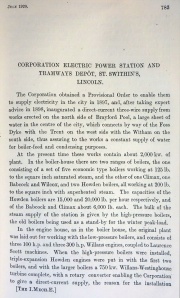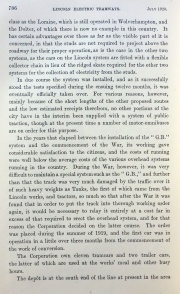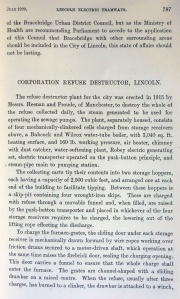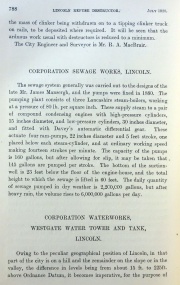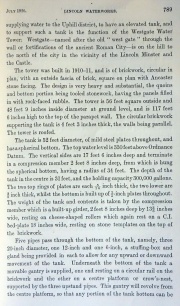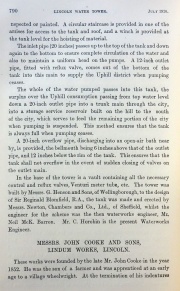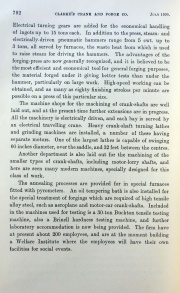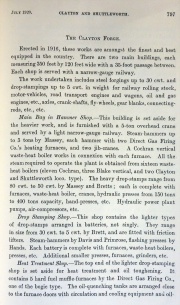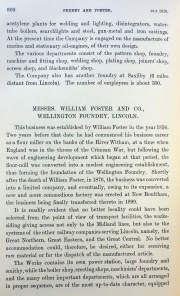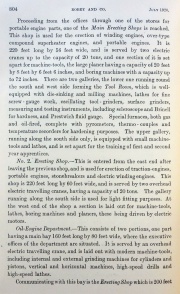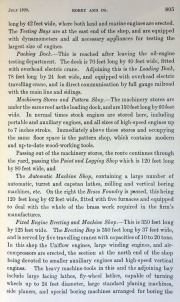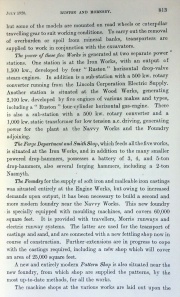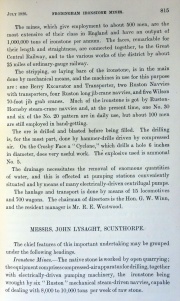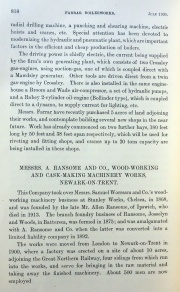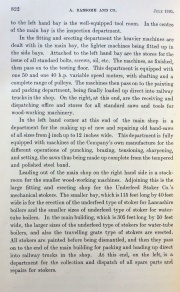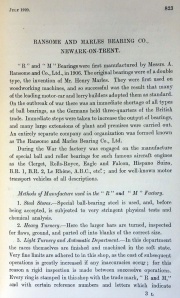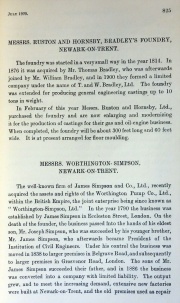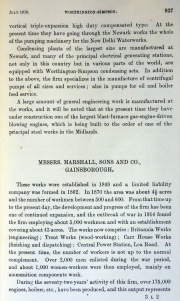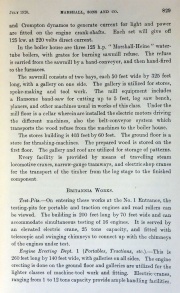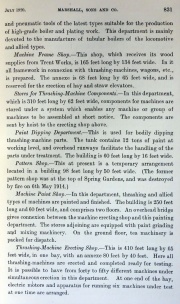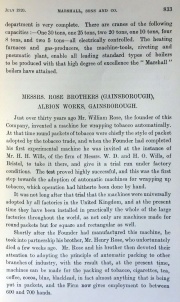1920 Institution of Mechanical Engineers: Visits to Works
Note: This is a sub-section of 1920 Institution of Mechanical Engineers
Visits to Works (Excursions) to Lincoln
Lincoln Power Station
CORPORATION ELECTRIC POWER STATION AND TRAMWAYS DEPOT, ST. SWITHIN'S, LINCOLN.
The Corporation obtained a Provisional Order to enable them to supply electricity in the city in 1897, and, after taking expert advice in 1898, inaugurated a direct-current three-wire supply from works erected on the north side of Brayford Pool, a large sheet of water in the centre of the city, which connects by way of the Foss Dyke with the Trent on the west side with the Witham on the south side, thus assuring to the works a constant supply of water for boiler-feed and condensing purposes.
At the present time these works contain about 2,000 kw. of plant. In the boiler-house there are two ranges of boilers, the one consisting of a set of five economic type boilers working at 125 lb. to the square inch saturated steam, and the other of one Climax, one Babcock and Wilcox, and two Howden boilers, all working at 200 lb. to the square inch with superheated steam. The capacities of the Howden boilers are 15,000 and 20,000 lb. per hour respectively, and of the Babcock and Climax about 6,000 lb. each. The bulk of the steam supply of the station is given by the high-pressure boilers, the old boilers being used as a stand-by for the winter peak-load.
In the engine house, as in the boiler house, the original plant was laid out for working with the low-pressure boilers, and consists of three 100 h.p. and three 300 h.p. Winans engines, coupled to Laurence Scott machines. When the high-pressure boilers were installed, triple-expansion Howden engines were put in with the first two boilers, and with the larger boilers a 750 kw. Willans-Westinghouse turbine complete, with a rotary converter enabling the Corporation to give a direct-current supply, the reason for the installation of the A.C. generator being that the original engine-house was too narrow to allow for the extra length required for a D.C. turbine.
During the War it was necessary to give a 3,300-volt power supply to one of the large firms in the city, and this was taken from the A.C. turbo-generator by way of a step-up transformer. As the extra demands of the War expanded, the Corporation were not able to cope with the power requirements for this particular firm, the result being that the firm themselves acquired a large secondhand plant and built their own power station having a capacity of 4,400 kw. on the other side of the river from their works. This consisted of three 750 kw. turbo-generators by the A.E.G. Company, and one new 2,000 kw. by the B.T.H. Company, all operated at 3,300 volts, 50 periods. The boiler house contained four land-type Babcock and Wilcox boilers, coal being obtained off a private siding from the adjacent railway, and water from the river.
At the beginning of 1918 the Corporation, having in the interim lost other power supplies through insufficiency of plant, called in Sir John Snell on the question of expanding their generating station, and, acting under his advice, negotiations were entered into with Messrs. Clayton and Shuttleworth, the owners of the new station above referred to, and were concluded during the summer of 1918. In August of last year the Corporation finally took over the working of the new station, on which they immediately commenced extensions, which include the putting down at the earliest possible moment two 5,000 kw. turbo-alternators, generating at 6,600 volts, 50 periods, together with four marine type Babcock boilers, each capable of an evaporation of 36,000 lb. of water per hour, and all necessary auxiliaries.
The contract for this new plant was placed in June of 1919, and delivery and erection was promised in twelve months. Owing, however, to the disastrous effect. of the moulders' strike, the plant will not now be forthcoming until the end of the year, and probably not in operation before February or March of 1921. As the Corporation are faced with a serious shortage of plant for the winter of 1920-21, they have now decided on the immediate installation of a second-hand plant of 2,000 kw. capacity, which they hope to have in operation in October.
For the purpose of carrying out the extensions, the Corporation acquired an extra five acres of land, in order to provide for large coal storage and for buildings for a final plant capacity of about 40,000-50,000 kw. They also have to provide for the fact that during any dry spell in the summer months the flow of water in the River Witham is very slight, and therefore a large cooling tower capacity will ultimately be necessary. The ground acquired is largely in the nature of a swamp in the wet season, and the whole of the buildings and plant therefore have to be carried on piles, seine 400 of which (in reinforced concrete) have had to be driven for the extensions at present in hand. The Corporation, before commencing the extensions, entered into contracts with various firms in this city, and it is anticipated that the bulk of the capacity of the two new sets will be forthwith required to supply the demand. Since Sir John Snell became first Chief Electricity Commissioner, Mr. A. H. Preece has acted as Consultant to this Corporation in connexion with these extensions.
Lincoln Tramways
TRAMWAYS.
In 1901 the Corporation obtained powers under a private Bill to provide tramways for the whole of the city. At that time the only tramways existing consisted of a line of horse-drawn vehicles running from the centre of the city southwards into the adjoining District Council of Bracebridge, a distance of 11 miles of route, operated by a private company, working under an Act which gave the Corporation powers to purchase at the end of twenty-one years. This period expired in 1905, and the undertaking of the Company was duly acquired, and it was forthwith decided that the line should be electrified.
As Lincoln, however, was an ancient city with many architectural beauties, the Corporation of that period were of opinion that the installation of the overhead system would be an eye-sore, and it was finally decided to lay down the "G.B." surface contact system on the High Street route for trial purposes, and if it proved satisfactory to consider its installation on the other routes as in the schedule in the Bill. This system belongs to the same class as the Loraine, which is still operated in Wolverhampton, and the bolter, of which there is now no example in this country. It has certain advantages over these as far as the visible part of it is concerned, in that the studs are not required to project above the roadway for their proper operation, as is the case in the other two systems, as the cars on the Lincoln system are fitted with a flexible collector chain in lieu of the ridged skate required for the other two systems for the collection of electricity from the studs.
In due course the system was installed, and as it successfully stood the tests specified during the ensuing twelve months, it was eventually officially taken over. For various reasons, however, mainly because of the short lengths of the other proposed routes and the low estimated receipts therefrom, no other portions of the city have in the interim been supplied with a system of public traction, though at the present time a number of motor-omnibuses are on order for this purpose.
In the years that elapsed between the installation of the "G.B." system and the commencement of the War, its working gave considerable satisfaction to the citizens, and the costs of running were well below the average costs of the various overhead systems running in the country. During the War, however, it was very difficult to maintain a special system such as the "G.B.," and further than that the track was very much damaged by the traffic over it of such heavy weights as Tanks, the first of which came from the Lincoln works, and tractors, so much so that after the War it was found that in order to put the track into thorough working order again, it would be necessary to relay it entirely at a cost far in excess of that required to erect the overhead system, and for that reason the Corporation decided on the latter course. The order was placed during the summer of 1919, and the first car was in operation in a little over three months from the commencement of the work of conversion.
The Corporation own eleven tramcars and two trailer cars, the latter of which are used at the works' meal and other busy hours.
The depot is at the south end of the line at present in the area of the Bracebridge Urban District Council, but as the Ministry of Health are recommending Parliament to accede to the application of this Council that Bracebridge with other surrounding areas should be included in the City of Lincoln, this state of affairs should not be lasting.
Lincoln Refuse Destructor
CORPORATION REFUSE DESTRUCTOR, LINCOLN.
The refuse destructor plant for the city was erected in 1915 by Messrs. Heenan and Fronde, of Manchester, to destroy the whole of the refuse collected daily, the steam generated to be used for operating the sewage pumps. The plant, separately housed, consists of four mechanically-clinkered cells charged from storage receivers above, a Babcock and Wilcox water-tube boiler, with 3,040 sq. ft. heating surface, and 160 lb. working pressure, air heater, chimney with dust catcher, water-softening plant, Robey electric generating set, electric transporter operated on the push-button principle, and steam-pipe main to pumping station.
The collecting carts tip their contents into two storage hoppers, each having a capacity of 2,500 cubic feet, and arranged one at each end of the building to facilitate tipping. Between these hoppers is a skip-pit containing four wrought-iron skips. These are charged with refuse through a movable funnel and, when filled, are raised by the push-button transporter and placed in whichever of the four storage receivers requires to be charged, the lowering out of the lifting rope effecting the discharge.
To charge the furnace-grates, the sliding door under each storage receiver is mechanically drawn forward by wire ropes working over friction drums secured to a motor-driven shaft, which operation at the same time raises the firebrick door, sealing the charging opening. This door carries a funnel to ensure that the whole charge shall enter the furnace. The grates are channel-shaped with a sliding drawbar on a raised centre. When the refuse, usually after three charges, has burned to a clinker, the drawbar is attached to a winch, the mass of clinker being withdrawn on to a tipping clinker truck on rails, to be deposited where required. It will be seen that the arduous work usual with destructors is reduced to a minimum.
The City Engineer and Surveyor is Mr. R. A. MacBrair.
Lincoln Sewage Works
CORPORATION SEWAGE WORKS, LINCOLN.
The sewage system generally was carried out to the designs of the late Mr. James Mansergh, and the pumps were fixed in 1880. The pumping plant consists of three Lancashire steam-boilers, working at a pressure of 80 lb. per square inch. These supply steam to a pair of compound condensing engines with high-pressure cylinders, 15 inches diameter, and low-pressure cylinders, 30 inches diameter, and fitted with Davey's automatic differential gear. These actuate four ram-pumps, 22 inches diameter and 5 feet stroke, one placed below each steam-cylinder, and at ordinary working speed making fourteen strokes per minute. The capacity of the pumps is 160 gallons, but after allowing for slip, it may be taken that 145 gallons are pumped per stroke. The bottom of the suction- well is 23 feet below the floor of the engine-house, and the total height to which the sewage is lifted is 60 feet. The daily quantity of sew-age pumped in dry weather is 2,200,C00 gallons, but after heavy rain, the volume rises to 6,000,000 gallons per day.
Lincoln Waterworks
CORPORATION WATERWORKS, WESTGATE WATER TOWER AND TANK, LINCOLN.
Lincoln Waterworks
Owing to the peculiar geographical position of Lincoln, in that part of the city is on a hill and the remainder on the slope or in the valley, the difference in levels being from about 15 ft. to 225ft. above Ordnance Datum, it becomes imperative, for the purpose of supplying water to the Uphill district, to have an elevated tank, and to support such a tank is the function of the Westgate Water Tower: Westgate — named after the old "west gate" through the wall or fortifications of the ancient Roman City — is on the lull to the north of the city in the vicinity of the Lincoln Minster and the Castle.
The tower was built in 1910-11, and is of brickwork, circular in plan, with an outside fascia of brick, square on plan with Ancaster stone facing. The design is very heavy and substantial, the quoins and bottom portion being tooled stonework, having the panels filled in with rock-faced rubble. The tower is 56 feet square outside and 48 feet 9 inches inside diameter at ground level, and is 117 feet 6 inches high to the top of the parapet wall. The circular brickwork supporting the tank is 4 feet 3 inches thick, the walls being parallel. The tower is roofed.
The tank is 52 feet diameter, of mild steel plates throughout, and has a spherical bottom. The top water level is 330 feet above Ordnance Datum. The vertical sides are 17 feet 6 inches deep and terminate in a compression member 2 feet 8 inches deep, from which is hung the spherical bottom, having a radius of 34 feet. The depth of the tank in the centre is 31 feet, and the holding capacity 300,000 gallons. The two top rings of plates are each 5/16 inch thick, the two lower are inch thick, whilst the bottom is built up of 1/2 inch plates throughout. The weight of the tank and contents is taken by the compression member which is a built-up girder, 2 feet 8 inches deep by 13 3/8 inches wide, resting on cheese-shaped rollers which again rest on a C.I. bed-plate 18 inches wide, resting on stone templates on the top of the brickwork.
Five pipes pass through the bottom of the tank, namely, three 20-inch diameter, one 12-inch and one 6-inch, a stuffing-box and gland being provided in each to allow for any upward or downward movement of the tank. Underneath the bottom of the tank a movable gantry is supplied, one end resting on a circular rail on the brickwork and the other on a centre platform or crow's-nest, supported by the three upstand pipes. This gantry will revolve from the centre platform, so that any portion of the tank bottom can be respected or painted. A circular staircase is provided in one of the arises for access to the tank and roof, and a winch is provided at the tank level for the hoisting of material.
The inlet pipe (20 inches) passes up to the top of the tank and down again to the bottom to ensure complete circulation of the water and also to maintain a uniform head on the pumps. A 12-inch outlet pipe, fitted with reflux valve, comes out of the bottom of the tank into this main to supply the Uphill district when pumping ceases.
The whole of the water pumped passes into this tank, the surplus over the Uphill consumption passing from top water level down a 20-inch outlet pipe into a trunk main through the city, into a storage service reservoir built on the bill to the south of the city, which serves to feed the remaining portion of the city when pumping is suspended. This method ensures that the tank is always full when pumping ceases.
A 20-inch overflow pipe, discharging into an open-air bath near by, is provided, the bellmouth being 6 inches above that of the outlet pipe, and 12 inches below the rim of the tank. This ensures that the tank shall not overflow in the event of sudden closing of valves on the outlet main.
In the base of the tower is a vault containing all the necessary control and reflux valves, Venturi meter tube, etc. The tower was built by Messrs. G. Henson and Sons, of Wellingborough, to the design of Sir Reginald Blomfield, R.A., the tank was made and erected by Messrs. Newton, Chambers and Co., Ltd., of Sheffield, whilst the engineer for the scheme was the then waterworks engineer, Mr. Neil McK. Barron. Mr. C. Horobin is the present Waterworks Engineer.
John Cooke and Sons
MESSRS. JOHN COOKE AND SONS, LINDUM WORKS, LINCOLN.
John Cooke and Sons
These works were founded by the late Mr. John Cooke in the year 1852. He was the son of a farmer and was apprenticed at an early age to a village wheelwright. At the termination of his indentures he started in business as a cart and wagon builder, fashioning much of the work with his own hands, and originating a number of new vehicles for farm purposes. He settled in Lincoln subsequently in order to meet an existing demand for the new types of ploughs and agricultural vehicles he had designed. One of his models was a feature of the Royal Agricultural Show in Lincoln, in 1854.
He died in 1887, leaving the business in the hands of his two sons and partners, Mr. William Cooke and Mr. Frank Cooke, of whom the latter survives. The special work carried on is the manufacture of single, double, three- and four-furrow tractor-ploughs, ridging, earthing and potato-lifting ploughs, harrows, horse-hoes, cultivators, flat rollers, clod-crushers, etc. In the vehicle department, carts, wagons, drays, traps, milk and cattle floats, liquid manure and water-carts are built.
Clarkes Crank and Forge Co
MESSRS. CLARKE'S CRANK AND FORGE CO., LINCOLN.
Clarkes Crank and Forge Co
This firm was founded on its present site in Lincoln in 1859. For over sixty years the Company has specialized in the manufacture of crank-shafts, and all types of general engine forgings. To-day they undertake any class of engine and marine forgings, in addition to their speciality, namely, crank-shafts. The Company has recently become associated with the Agricultural and General Engineers, Ltd., an association of many of the leading East Anglian engineering firms. In 1909 the Company was reconstructed by the present managing director, Mr. Louis W. Smith, and during the last ten years it has quadrupled in size and output. The works are now efficiently equipped with modern steam forging-presses, hammers, and machine-tools, and can supply forgings or finished machined crank-shafts up to 10 tons in weight each.
The chief feature of the forge is the large Davy Steam Hydraulic Intensifier type of press, having a power of 1,200 tons, and served by two electric travelling cranes of 30 and 10 tons capacity.
Electrical turning gears are added for the economical handling of ingots up to 15 tons each. In addition to the press, steam- and electrically-driven pneumatic hammers range from 5 cwt. up to 3 tons, all served by furnaces, the waste beat from which is used to raise steam for driving the hammers. The advantages of the forging-press are now generally recognized, and it is believed to be the most efficient and economical tool for general forging purposes, the material forged under it giving better tests than under the hammer, particularly on large work. High-speed working can be obtained, and as many as eighty finishing strokes per minute are possible on a press of this particular size.
The machine shops for the machining of crank-shafts are well laid out, and at the present time further extensions are in progress. All the machinery is electrically driven, and each bay is served by an electrical travelling crane. Heavy crank-shaft turning lathes and grinding machines are installed, a number of these having separate motors. One of the largest lathes is capable of swinging 60 inches diameter, over the saddle, and 32 feet between the centres.
Another department is also laid out for the machining of the smaller types of crank-shafts, including motor-lorry shafts, and here are seen many modern machines, specially designed for this class of work.
The annealing processes are provided for in special furnaces fitted with pyrometers. An oil tempering bath is also installed for the special treatment of forgings which are required of high tensile alloy steel, such as aeroplane and motor-car crank-shafts. Included in the machines used for testing is a 30-ton Buckton tensile testing machine, also a Brinell hardness testing machine, and further laboratory accommodation is now being provided. The firm have at present about 200 employees, and are at the moment building a Welfare Institute where the employees will have their own facilities for social events.
Clayton and Shuttleworth
MESSRS. CLAYTON AND SHUTTLEWORTH, LINCOLN.
Clayton and Shuttleworth
These works, established in 1842 by Nathaniel Clayton and Joseph Shuttleworth on a plot of land measuring acres and giving employment to 100 men, now cover about 100 acres and employ approximately 5,000 work people. The original business was iron-founding in which line Nathaniel Clayton was an acknowledged expert, being ably assisted by his partner, a skilled engineer and inventor. About this tune considerable developments were being made in the steam-engine, particularly in its application to road-haulage and agricultural work.
In the year 1845 Messrs. Clayton and Shuttleworth made their first portable engine, which, with the thrashing machine, might be said to have revolutionized agriculture. The inventive ability of the founders may be judged by the number of inventions brought out during the succeeding years, including the placing of a steam-jacketed cylinder in the upper part of the smoke-box in portable and traction engines; the adoption of spur-gearing for transmitting the power from the crank-shaft to the axle; the older method of chain-drive did not die easily, as it was not until about 1870 that this was finally discarded by other makers. To date, over 120,000 thrashers and engines have been made and dispatched to every country in the world.
The products of the company now include in addition to thrashing machinery, portable engines and traction engines, steam-tractors, road-rollers, chain-track tractors, crude-oil engines and boilers, including the "Spearing" water-tube.
Recently a subsidiary company called Clayton Wagons, Ltd., was formed to take over the Titanic Works, the Abbey Works, and the Clayton Forge, to specialize on steam and electric road-wagons, railway rolling-stock and drop stampings and steel forgings respectively. This company is very closely associated with the parent Company.
Stamp End Works
These works cover the site of the original shop and extend to about 25 acres, The principal manufactures include steam tractors, traction engines, portable engines, road-rollers, trailer-wagons, thrashing machines, clover-hullers, chaff-cutters, elevators, crude oil engines, and chain-track tractors, locomotive and water-tube boilers.
Machine Shop.- Used as general machine shop for machining parts of traetion-engine, tractors, road-rollers, steam- wagons, etc.
Reeding Shop.— Steam-wagon erecting shop.
Test Shed.— Steam-wagons, tractors, traction-engines, road-rollers, and portable engines. etc., undergo a thorough steam-test in this shed.
Tractor Erecting Shop.- Here, in addition to strain-tractors, traction-engines and road-rollers, will be seen the "Clayton 35 b.h.p. Chain-Track Tractor, of which 1,000 have been built since 1.917, being largely used by the Food Production Department of the 'Ministry of Food for agricultural purposes in Britain. They were also used for hauling heavy guns, etc., in France. It is interesting to note that the pressure on the ground undernentb the track is only about 3 lb. per square inch.
Steel Foundry.- The steel foundry covers an area of 3,100 square yards and is served by one 25-ton, one 5-ton, and five 3-ton overhead electric cranes. Machine moulding machines are largely used, and include:- One Macdonald's No 12, capable of taking work about 4 feet square, and titled with electric jarring and pneumatic lifting gear; two No. 6 machines by the same makers, and two Britannia machines.
The steel is melted in two "Heroult" electric furnaces, each with capacity of 30 cwt. and capable of a melt every four hours. The furnaces are supplied with three-phase current at 50 cycles and 110 volts. There are two large Direct this Firing Co.'s annealing furnaces, and two drying furnaces.
The fettling shop is equipped with pneumatic chippers, Noble and Lund handsaws, stationary and pendulum grinders, electric and oxy-acetylene welding plants, and a complete shot blasting plant by Tilghman, of sufficient capacity for the needs of both steel and iron foundries. A well-equipped laboratory is run in conjunction with the foundries and the drop-forging plant.
Iron Foundry. -This is in two bays, and has a floor area of approximately 2,000 square yards. The main bay is served by two electric overhead cranes in addition to wall cranes, narrow-gauge railways, etc.
The second bay, where the smaller work is carried out, has one electric overhead crane, railways, etc., one 10-ton and one 4-ton cupola, with their spouts connected so that metal can be run into the same ladle if required, and a Macdonald No. 12 moulding machine operated by compressed air.
Boiler Shop.— This is a square building measuring 250 feet, in five bays. Each bay is served by an overhead electric crane, and in addition there is a large number of wall jib cranes.
The flanging presses include one 350.ton, one 130-ton, one 120- ton, two 200-ton, two plate-edge planing machines with 20 feet gap, four hydraulic riveting machines 8 feet by 10 feet 6 inches gap, one Campbell and Hunter horizontal boiler drilling machine with rotary table. Wicksteed hack-sawing machine for trimming the edges of flanged plates, etc., and electric welding plant.
The work undertaken includes boilers for steam road-wagons, tractors, traction-engines, road-rollers, portable engines, Tanks, steel bodies for wagons, locomotive boilers for outside firms, the " Spearing " water-tube boiler and:superheaters.
WOOD-WORKING DEPARTMENTS.
Thrasher Erection Shop.— The finished parts are drawn from stores, which extend the full length on one side, and assembled on the thrasher. The latest improvement in the "Clayton" thrashing machine is the fitting of self-aligning ball-bearings throughout.
Thrasher Paint Shop.— In this department thrashing machines, chaff-cutters, etc., are finally tested and painted ready for dispatch.
Thrasher Machine-Shop and Tool-Room.— All thrasher parts are machined here and delivered into the stores for stock.
Saw Mill.— Here all material for thrashers, chaff-cutters, and wagon bodies, is prepared. The equipment includes circular and band-saws, a dimension saw by Robinson and Son, Rochdale, and an end-tenoning machine which will take material up to 12 inches by 6 inches; planing, morticing and spindling machines, a spoke-turning machine. All machines are driven by independent motors. The dust and shavings are carried by suction ducts direct to the boiler house.
TITANIC WORKS.
Oil-Engine Machine Shop.— This department is engaged solely on the machining of parts for the "Clayton" crude-oil engines of which large numbers are exported annually, being valveless and extremely simple in design. It is specially suitable where native or unskilled labour is employed. The top end of this shop is set aside for testing, each engine undergoing a thorough brake test, and in addition an indicator test.
Oil-Engine Erecting Shop.— The assembling of oil-engines is carried on in this shop. New Works.—This is a building measuring 1,000 feet long by 75 feet wide, having a gallery on either side, and is set aside solely for the manufacture of Clayton steam and electric road wagons. Modern mass production methods are adopted. The plant includes Churchill and Norton grinders, lathes, Dickinson's horizontal boring machines, Smith and Coventry milling machines, Herbert's vertical milling machines, Wallsvork's gear cutter, Darling and Seller's bevel-gear slotting machine, and the lighter machines, lathes, vertical drills, saws, 'totters, broaches, etc., on the gallery.
THE CLAYTON FORGE.
Erected in 1916, these works are amongst the finest and best equipped in the country. There are two main buildings, each measuring 350 feet by 120 feet wide with a 35-foot passage between. Each shop is served with a narrow-gauge railway.
The work undertaken includes steel forgings up to 30 cwt. and drop-stampings up to 5 cwt. in weight for railway rolling stock, motor-vehicles, road transport engines and wagons, oil and gas engines,'etc., axles, crank-shafts, fly-wheels, gear blanks, connecting-rods, etc., etc.
Main Bay in Hammer Shop.—This building is set aside for the heavier work, and is furnished with a 5-ton overhead crane and served by a light narrow-gauge railway. Steam-hammers up to 3 tons by Massey, each hammer with two Direct Gas Firing Co.'s heating furnaces, and two jib-cranes. A Cochran vertical waste-heat boiler works in connexion with each furnace. All the steam required to operate the plant is obtained from sixteen waste- heat boilers (eleven Cochran, three Blake vertical, and two Clayton and Shuttleworth loco. type). The heavy drop-stamps range from 80 cwt. to 50 cwt. by Massey and Bretts; each is complete with furnaces, waste-heat boiler, cranes, hydraulic presses from 150 tons to 400 tons capacity, hand-presses, etc. Hydraulic power plant pumps, air-compressors, etc.
Drop Stamping Shop.— This shop contains the lighter types of drop-stamps arranged in batteries, not singly. They range in size from 30 cwt. to 5 cwt. by Brett, and are fitted with friction lifters. Steam-hammers by Davis and Primrose, flashing presses by Hands. Each battery is complete with furnaces, waste-heat boilers, presses, etc. Additional smaller presses, furnaces, grinders, etc.
Heat Treatment Shop.— The top end of the lighter drop-stamping shop is set aside for heat treatment and oil toughening. It contains 5 hard fuel muffle-furnaces by the Direct Gas Firing Co., one of the bogie type. The oil-quenching tanks are arranged close to the furnace doors with circulation and cooling equipment and oil-cleansing arrangements. The necessary equipment for tensile tests, Brinell and Izod tests, is in an adjoining building.
Die-Cutting Shop.— The shop measures 350 feet by 50 feet and is served by a 5-ton overhead electric crane. It contains planers by Woodward and Rowell, Redman planer, Stick lathes, Mitchell new model lathes, Selson slotters, Jackson's die sinkers, shapers, boring mills, saws, drills and grinders. The lower end contains a tool room, inspection department, and bar store.
ABBEY WORKS.
Rolling Stock Departments.— These buildings, measuring 500 feet by 450 feet, were built during the War as aeroplane erecting shops, but have since been equipped for the construction of all classes of rolling stock—Pullman cars, passenger coaches, goods wagons, etc. Hydraulic and compressed-air services are installed throughout the buildings. An electric traverser having 70 feet span, by Cowan and Sheldon, extends the full length of the shops on the river side and will be used for transferring vehicles from the various bays or into a siding leading to the main lines.
The following shops will next be seen: Pullman Car Shop, Wagon Erecting Shop, Wagon Repair Shop, Carriage Repair Shop, Paint Shop.
Underframe Shop.—This bay is served by two overhead 5-ton electric cranes by Vaughan; riveting machines by Musgrave.
Bar Preparation Shop.—The bay is traversed by two Vaughan overhead electric cranes. It contains Wilkins and Mitchell's milling machines with fixed and movable heads, eight head-beam driller, 36-spindle drill, punching and shearing machines, saws, presses, etc.
Machine Shop.— The plant here comprises lathes, milling machines, grinding machines, drills, planers, slotting machines, shapers, screwing machines, etc.
Wood-Working Shop.— This contains moulding machines, band and circular saws by Robinson, dimension saw, Sagar sandpapering machine, drilling and boring machines, etc.
Finishing and Polishing Shop.— Fittings for Pullman cars, passenger coaches, etc. are finished, polished, etc., in this shop.
Canteen.— There is a large well-equipped canteen for work- people, staff and managers.
Huts for Workers.— To overcome the housing shortage, a number of huts in which German prisoners were housed during the War have been converted by Messrs. Clayton and Shuttleworth into living quarters for married workmen.
Richard Duckering
MESSRS. RICHARD DUCKERING, WATERSIDE WORKS, LINCOLN.
Richard Duckering
These works were started in 1845 by Mr. Richard Duckering, for the manufacture of kitchen ranges and agricultural implements, and he was followed by his son, Mr. Charles Duckering, who retired from the business in 1912, and died five years later. Mr. Richard Duckering (grandson of the founder) took over the business in 1917, and early in the present year turned it into a limited liability company.
From the beginning, the foundry has formed the chief portion of the business, and is at present being extended to meet the constantly increasing demand for high-class iron castings, for which the firm have always had a good reputation.
Penney and Porter
MESSRS. PENNEY AND PORTER, LINCOLN.
Penney and Porter
This business is an amalgamation of the two original firms of Penney and Co., Ltd., City Iron and Steel Works, established in 1868, and Porter and Co., Gowts Bridge Works, established in 1855. In 1919 the present title of the firm was adopted.
The business carried on is that of general engineering, and the comprehensive lines of manufacture include gas-holders and tanks, constructional work, coal-gas plants, corn and gravel screens, and seed-dressing machinery. Machinery for treating flax seed and fibre, acetylene plants for welding and lighting, disintegrators, water-tube boilers, searchlights and steel, gun-metal and iron castings. At the present time the Company is engaged on the manufacture of marine and stationary oil-engines, of their own design.
The various departments consist of the pattern shop, foundry, machine and fitting shop, welding shop, plating shop, joiners' shop, screen shop, and blacksmiths' shop.
The Company also has another foundry at Saxilby (6 miles distant from Lincoln). The number of employees is about 300.
William Foster and Co
MESSRS. WILLIAM FOSTER AND CO., WELLINGTON FOUNDRY, LINCOLN.
William Foster and Co
This business was established by William Foster in the year 1856. Two years before that date he had commenced his business career as a flour miller on the banks of the River Witham, at a time when England was in the throes of the Crimean War, but following the wave of engineering development which began at that period, the flour-mill was converted into a modest engineering establishment, thus forming the foundation of the Wellington Foundry. Shortly after the death of William Foster, in 1876, the business was converted into a limited company, and eventually, owing to its expansion, a new and more commodious factory was erected at New Boultham, the business being finally transferred thereto in 1899.
It is readily evident that no better locality could have been selected from the point of view of transport facilities, the works- siding giving access not only to the Midland lines, but also to the systems of the other railway companies serving Lincoln, namely, the Great Northern, Great Eastern, and the Great Central. No better accommodation could, therefore, be desired, either for receiving raw material or for the dispatch of the manufactured article.
The Works contains its own power station, large foundry and smithy, while the boiler shop, erecting shops, machinists' departments, and the many other important departments, which are all arranged in proper sequence, are of the most up-to-date character, equipped so as to secure the advantages of the close specialization and standardization which are demanded to-day.
Here for many years past the firm has manufactured, in ever- increasing numbers each year, portable steam-engines, steam traction-engines, road locomotives, thrashing machines, maize shellers, straw elevators, chaff cutters, traction-wagons, and other similar machinery, which have gained an excellent reputation.
In 1903 the firm commenced the manufacture of steam-tractors, and since that year have built improved models from time to time, acquiring in 1909 the rights for the basic patent for suspending the rear part of the tractor on springs placed above the axle and outside the horn plates.
For heavy haulage work, road locomotives up to 65 b.h.p. are manufactured, equipped either as ordinary haulage engines or, if necessary, with all the fittings and elaborate finish required by travelling showmen, with which profession the engines have a splendid reputation.
During the Great War, 1914-1918, the Wellington Foundry was fully occupied on munitions of war, firstly in designing and building large numbers of 105 h.p. petrol tractors and suitable wagons for hauling 15-inch howitzers at the front, and executing other important contracts.
From 1915 onwards, until after the conclusion of hostilities, Tanks were built, for it was here that the designing and construction of the "Mother" type of tank took place, the Managing Director of the firm, Sir William A. Tritton (with whom in this work was associated Major W. G. Wilson), receiving Knighthood on the 13th February 1917 — a fitting tribute to the predominant share he had taken in the evolution of the tanks. Here, too, were designed and constructed the "Whippet" and "Hornet" types of Tank, the former of which played an important part in the decisive battles of 1918, the latter, at the time of cessation of hostilities, not having seen service in the field.
As soon as the Tanks had proved their worth as a weapon of war at the battle of the Somme in September, 1916, larger orders than had hitherto been placed for these machines were entrusted to the firm, and in consequence a new erecting shop was built in 1917.
Simultaneously with the building of this new shop, extensive additions were made to the boiler shop, whirls is amply equipped with up-to-date tools, and hydraulic and other appliances, both the new erecting shop and the boiler shop being served by powerful electric and other cranes. Additional land was also purchased as a special test field for Tanks, the terrain being made to resemble as nearly as possible the actual conditions met with in France, the field having its own railway siding. Now that the War is over, this test field will form an excellent ground on which to test traction-engines, etc.
Since the cessation of hostilities, the firm, in addition to resuming the manufacture of their normal products, namely, traction-engines, steam-tractors, road locomotives, portable engines, thrashing machines, maize shellers, chaff-cutters, straw-elevators, traction- wagons and trailers, etc., have also commenced the manufacture of compound steam-wagons, which are working with unqualified success.
During the War, owing to the demands for the Tanks, the firm employed some 2,000 workmen, and now in time of peace the number stands at about 1,000 workmen, the total area of the Works and land being about 24i acres.
Robey and Co
MESSRS ROBEY AND CO., GLOBE WORKS, LINCOLN.
Robey and Co
These works, whirls now cover an area of over 12 acres of ground, were started in 1854. They are quite near the centre of the city, and as will be seen from the plan, are situated in Canwick Road whirls may be reached from the High Street by St. Mary's Street, Portland Street, or Monson Street. They were started originally on a small scale, and designed principally for the production of steam-engines and thrashing-machines for agricultural purposes, and to this branch of the trade, together with steam ploughing and the manufacture of traction engines, the first few years were devoted.
The under-type steam-engine was first made by Robey and Co., and the success of this led on to the manufacture of all classes of engines for industrial purposes, and the introduction and development in this country of the well-known drop-valve engine.
Originally a private firm, it was incorporated as a limited liability company in 1893, the present chairman being Mr. Alexander Trotter, and the managing director Mr. W. T. Bell, O.B.E., M.I.Mech.E. The works have now been fully developed to their maximum capacity, and large numbers of engines of all types are gent to all parts of the world every year.
The principal manufactures consist of the Robey "Uniflow" engine, the most economical type of engine of the present day, steam-winding engines, electric winding engines, air-compressors, over-type compound condensing engines, fitted with feed-water heater and superheater, and high-speed engines for electric generating purposes, and portable engines. It may be mentioned that these works were the first in England to be lighted by electricity, and the engines for the first electric lighting installation in London were made here.
While thrashing-machines and agricultural machines are no longer manufactured here, large numbers of portable engines, under-type engines, and locomotive and vertical boilers are dealt with every year. Road traction has always been a speciality, and dates back from the three-wheel traction engine up to the present compound tractor, traction-engines, road locomotives, and steam- wagons, and to meet the recent development and demand for the latter a separate department has been started.
This Firm was also the pioneer in this country of the manufacture of the semi-Diesel oil engine, and, as will be seen, this department is well-equipped for the production of this type of engine for either land or marine purposes, of which large numbers are being produced in powers from 6 h.p. up to 300 h.p.
The Main Entrance and Offices are in the centre of the Canwick Road frontage. This block consists of the hoard room, managing director's office, drawing office, and general office, estimating and costing offices, and secretary's office.
Proceeding from the offices through one of the stores for portable engine parts, one of the Main Erecting Shops is reached. This shop is used for the erection of winding engines, over-type compound superheater engines, and portable engines. It is 220 feet long by 56 feet wide, and is served by two electric cranes up to the capacity of 20 tons, and one section of it is set apart for machine-tools, the large planer having a capacity of 20 feet by 8 feet by 6 feet 6 inches, and boring machines with a capacity up to 72 inches.
There are two galleries, the lower one running round the south and west side forming the Tool Room, which is well-equipped with die-sinking and milling machines, lathes for fine screw-gauge work, oscillating tool-grinders, surface grinders, measuring and testing instruments, including scleroscope and Brinell for hardness, and Prestwich fluid gauge. Special furnaces, both gas and oil-fired, complete with pyrometers, thermo-couples and temperature recorders for hardening purposes. The upper gallery, running along the south side only, is equipped with small machine-tools and lathes, and is set apart for the training of first and second year apprentices.
No. 2. Erecting Shop.—This is entered from the east end after leaving the previous shop, and is used for erection of traction-engines, portable engines, stonebreakers and electric winding engines. This shop is 220 feet long by 60 feet wide, and is served by two overhead electric travelling cranes, having a capacity of 20 tons. The gallery running along the south side is used for light fitting purposes. At the west end of the shop a section is laid out for machine-tools, lathes, boring machines and planers, these being driven by electric motors.
Oil-Engine Department.—This consists of two portions, one part having a main bay 160 feet long by 80 feet wide, where the executive offices of the department are situated. It is served by an overhead electric travelling crane, and is laid out with modern machine-tools, including internal and external grinding machines for cylinders and pistons, vertical and horizontal machines, high-speed drills and high-speed lathes.
Communicating with this bay is the Erecting Shop which is 200 feet long by 42 feet wide, where both land and marine engines are erected. The Testing Bays are at the east end of the shop, and are equipped with dynamometers and all necessary appliances for testing the largest size of engines.
Packing Dock.—This is reached after leaving the oil-engine testing department. The dock is 70 feet long by 40 feet wide, fitted with overhead electric crane. Adjoining this is the Loading Dock, 78 feet long by 24 feet wide, and equipped with overhead electric travelling crane, and in direct communication by full gauge railroad with the main line and sidings.
Machinery Stores and Pattern Shop.—The machinery stores are under the same roof as the loading dock, and are 150 feet long by 60 feet wide. In normal times stock engines are stored here, including portable and auxiliary engines, and all sizes of high-speed engines up to 7 inches stroke. Immediately above these stores and occupying the same floor space is the pattern shop, which contains modern and up-to-date wood-working tools.
Passing out of the machinery stores, the route continues through the yard, passing the Paint and Lagging Shop which is 120 feet long by 80 feet wide, and -
The Automatic Machine Shop, containing a large number of automatic, turret and capstan lathes, milling and vertical boring machines, etc. On the right the Brass Foundry is passed, this being 120 feet long by 42 feet wide, fitted with five furnaces and equipped to deal with the whole of the brass work required in the firm's manufactures.
Fixed Engine Erecting and Machine Shop.—This is 350 feet long by 125 feet wide. The Erecting Bay is 350 feet long by 37 feet wide, and is served by five travelling cranes with capacities of 10 to 20 tons. In this shop the Uniflow engines, large winding engines, and air-compressors are erected, the section at the north end of the shop being devoted to smaller auxiliary engines and high-speed vertical engines. The heavy machine-tools in this and the adjoining bay include large facing lathes, fly-wheel lathes, capable of turning wheels up to 24 feet diameter, large standard planing machines, side planers, and special boring machines arranged for boring the main bearings and crosshead slides of horizontal engine beds at one setting.
In addition to the above the shop is well equipped with modern horizontal and radial drills, shaping and slotting machines, gear-cutting machine, and a 110 ton hydraulic press. An off-shoot in the west end of the shop contains a 30-ton power driven tensile testing machine, and a gallery which forms the shop Drawing Stores.
Galleries are arranged above the erecting and machine shops for brass finishing, assembling engine details, and for light machine- tools, including several spiral gear-cutting machines made by the firm.
Smith's Shop.—This is 150 feet long by 155 feet wide, having the usual smiths' fires, five Brett drop stamps up to 25 cwt., trimming presses, eight steam-hammers up to 50 cwt., three oil and coal fired furnaces with boilers, and one Bogie annealing furnace. Three bolt and nut machines, set of angle-bending rolls, one band-saw, bar-cutting machine, drilling and screwing machines, driven by motors.
Proceeding to the foundry, the Boiler Shop, 340 feet long by 155 feet wide, is passed on the right. This contains two sets of hydraulic pumps and accumulator, 100-ton and 200-ton hydraulic presses, 150-ton hydraulic punch, hydraulic riveters, plate-rolls, shearing machines, higli-speed drilling machines, oil-fired rivet furnaces, coal and oil-fired furnaces, and electric and acetylene welding and cutting plants. The shop is served by one 20-ton electric and eight 6-ton hydraulic cranes.
Foundry.—This is 215 feet long by 160 feet wide, and has three cupolas to melt 1, 3, and 5 tons per hour. The blast is provided by a motor-driven Sturtevant Fan, and the cupolas are charged from an overhead platform with hydraulic truck hoist. There are four core-ovens fired by coke, and four fired by gas from gas-producers. This shop is served by three electric travelling cranes, 15, 20, and 25 tons.
Power House.—The power house is 150 feet long by 40 feet wide, and is served by an overhead crane. There are two water-tube boilers fitted with chain-grate stokers, coal elevator, economizers, and constructed for a working pressure of 220 lb. and provided with motor-driven induced fan-draught, the feed-pumps taking their suction from the hot-well of each engine. The two boilers are capable of evaporating 32,000 lb. of steam per hour, each being provided with feed-water filter and water-meter.
The generating plant consists of two generating sets and one air-compressor for supplying the compressed air, which is in use all through the works.
The larger generating set consists of the firm's own type of Uniflow engine, having a capacity of 1,250 h.p., the cylinder being 35 inches by 40 inches stroke and running at 120 r.p.m. Mounted on the shaft is a direct-current generator having a voltage of 220-230 volts.
The smaller engine is of the same type having cylinder 29 inches diameter by 33 inches stroke, and running at 140 r.p.m. with generator mounted on the shaft with the same voltage as above. Each engine is fitted with forced lubrication, shaft-governor, oil-separator and condenser, the air-pumps of which are driven in each case from the engine crank-shaft.
Water, steam, and recording wattmeters are provided, also pressure recording apparatus. A CO2 recorder is fitted so that the flue gases from either boiler can be analysed whenever desired. A compound steam-driven two-stage air-compressor is included having steam-cylinders 13 inches and 23 inches, and air-cylinders 23 inches and 14 inches with a common stroke of 36 inches for delivering air at 80 lb. pressure, the steam-cylinders being fitted with the firm's well-known drop-valve gear, and the air-cylinders with the Robey light automatic disk-valves, and fitted with unloading device.
Steam-Wagon Department. —This department, which is situated on the north side of the main works, is entirely self-contained and solely devoted to the manufacture of the new Robey 5-ton steam- wagon, and consists of two large bays, one 290 feet long by 60 feet wide, and one 290 feet long by 78 feet wide. The former is at the present time being equipped with the most modern machine-tools, a large number of which are already installed, which have been specially selected for the mass production of the steam-wagon details; this bay, when completely equipped with the machines which are at present on order, will be able to deal with the whole of the machining for the steam-wagon, special jigs and tool equipment having been designed to procure rapid output and interchangeability.
At one end of the machine-shop bay there is a capacious store, from which every part in connexion with the production of the steam-wagon is drawn, no parts whatever being issued to the erectors until they have passed through the inspection department and into this store.
The detail assembling is carried out on galleries which overlook the machining bay, and these galleries are equipped for the assembling of units on a large scale.
The Assembling and Erecting Bay is 290 feet long by 78 feet wide. The assembling of the various units of the steam-wagon takes place at one end of this hay, and the wagon is gradually completed as it nears the other end, at which there is a large test-shed for testing the steam-wagon engines before the wagons are given a running test on the road. At the end of the erecting bay, the bodies are fitted, the wagons finally painted, and equipped ready for delivery.
Ruston and Hornsby
MESSRS. RUSTON AND HORNSBY, LINCOLN.
Ruston and Hornsby
By the amalgamation, in 1918, of Ruston, Proctor and Co., Ltd., of Lincoln, with Richard Hornsby and Sons, Ltd., of Grantham and Stockport, the name became Ruston and Hornsby, Ltd.; both companies were pioneers in the engineering industry, and both had attained a world-wide reputation.
RUSTON, PROCTOR AND CO.
In 1857, the late Mr. Joseph Ruston became a partner in the small millwrights' business in Lincoln of Burton and Proctor, which then became known as Ruston, Proctor and Co., and later, in 1889, was converted into a limited company, Mr. Joseph Ruston being the chairman until his death in 1897. The business extended continually and in 1918 the works covered nearly 100 acres with over 8,600 employees.
The firm made its reputation on agricultural engines and thrashing machines, fixed steam-engines and boilers, and in 1876 began building steam-navvies, of which the present Company is the largest and most important constructor in the kingdom. Later, oil-engines were added and a new type developed in 1909, in which the fuel is forced through a highly-efficient mechanical atomizer into the compressed charge. This again is now succeeded by a cold starting type, capable of using any crude or residual oil, and offering the same economy as the Diesel engine, without the complication of the air-compressor.
Gas-engines are also a speciality, together with gas-producers, for the utilization of material hitherto considered useless as fuel, such as general sawmill and other waste, nut shells, plum stones, sugar-cane refuse, cotton seed, and olive residue.
Another speciality is an exhaust-heat boiler, by which the waste heat from the gas-engine can be used for making steam for heating purposes.
The Company also makes steam and oil road-rollers, oil locomotives, and centrifugal pumps. It has developed an extensive trade in maize-shellers, thrashing machines, clover-hullers, baling presses, rice-hullers, and so on.
RICHARD HORNSBY AND SONS.
These works were commenced by Richard Hornsby in a small smithy on the Great North Road at Grantham in 1815. Small agricultural machines were made, worked by horses or by hand, and in time agricultural steam-engines, thrashing machines, and elevators were added.
In 1851, at the Great Exhibition, the Hornsby portable steam-engine took the first prize, and in 1859 the firm introduced into their ploughs the convex breast or mouldboard, which at the time was a new principle in design. Mowers, reapers, and self-binding harvesters were included in their manufactures, and these last still retain their position in spite of American competition.
In 1879 the firm was incorporated, and in 1901, when the oil-engine was emerging from the experimental stage, the Akroyd-Stuart patents were secured by the Company, and the manufacture of the Hornsby-Akroyd oil-engines commenced, which, rapidly taking a leading place, established the oil-engine, as a prime mover, all over the world.
In 1905, the Government offered a prize of £1,000 for a military tractor that would run 40 miles, carrying its own fuel. This prize, and a bonus of £180 for exceeding the requirements, was won by the Hornsby tractor with a two-cylinder Hornsby oil-engine. Immediately after the competition this prize tractor was fitted in the place of wheels with a chain-track, which was invented by Mr. David Roberts, the Managing Director of the Company, and became the "caterpillar," so nicknamed by the soldiers during its trials at Aldershot, and a forerunner of the now famous Tanks.
In 1906 the firm. of J. E. H. Andrew and Co., Ltd., constructors of the "Stockport" gas-engine, and the earlier "Bisschop" engine, which was one of the first English gas-engines to be sold, was amalgamated with Richard Hornsby and Sons, and the Stockport works added to those of Grantham.
By 1918 the Company employed 3,000 men, with works covering 80 acres.
1. The Iron Works.—For the manufacture of oil-engines, gas- engines, traction-engines and road-rollers, portable and semi- portable steam-engines, oil-well drilling engines, oil-locomotives, pumps and corn mills.
The Machine Shop at these works consists of nine bays covering an area of 94,000 sq. ft., and divided into No. 1, 2, and 3 Turneries. No. 1 Turnery is known as the Heavy Machine Sloop, dealing with the machining of engine-beds, cylinder-heads, crank-shafts and connecting-rods. This Turnery contains special machine-tools of the firm's own design for the boring and facing of oil-engine beds. The crank-pins are turned in a Gardner's largest size crank-pinning machine. No. 2 and No. 3 Turneries are known as Light Machine Shops, in which details are manufactured for standard oil- and gas-engines, and portable and traction engines. The main feature is the grouping of various classes of machines, which increases the output with the minimum amount of transport. Jig and tool stores have been recently erected in No. 2 Turnery on up-to-date lines.
The machine tools in these turneries are all of modern design by the leading makers. The brass-working machinery and the semi- and full-automatic machines are arranged in galleries, running the length of the main machine-shops.
The Grinding Shop is situated in one of the machine bays and consists of universal plain surface and internal grinders, the largest being a 36-inch by 192-inch electrically-driven plain grinder dealing with crank-shafts, etc.
The finished part stores are situated below the turret and automatic gallery.
2. The Wood Works, covering 18 acres, are set apart for the manufacture of thrashers, bruisers, sifters, clover-hullers, chaff-cutters, rice-thrashers, rice-hullers, maize shelters, elevators, self- feeders, baling presses, and traction-wagons, and an agricultural tractor, which is being produced on mass-production lines and in very large quantities. The machines, and their parts, are all painted and varnished by the dipping process, the dipping tanks being of a size to take the largest assembled parts with the greatest ease. The main turnery covers 27,180 sq. ft., and is filled with the most up-to-date machinery that it has been possible to obtain.
3. The Motor Works, where the Ruston-Hornsby 16-20, 4-5 seater touring car is built, is a special product of the War. Originally used for the storage of agricultural machinery, when the War broke out this store was turned,' into an aeroplane works, which, extending with mushroom-like rapidity, was turning out 25 to 30 engines and 30 aeroplanes every week. Much of the machinery for this was supremely well fitted for car production, and cars are now being turned out in the same efficient and rapid fashion as the aeroplanes.
The total area of the Machine Shop alone is 47,700 sq. ft., whilst the Tool Room (which supplies all the works) covers 10,800 sq. ft. There are spacious erecting and dismantling shops and specially erected buildings for the heat treatment of metal.
These works are able to turn out 50 cars per week, rising to 100 very shortly. A special feature is a battery of machines for all types of gear cutting. The Mess Room is able to seat 1,060 employees at once.
4. The Boiler Works.—This is one of the largest and best equipped works for the manufacture of Lancashire, Cornish, flue or tube, dryback, vertical, water-tube and exhaust-heat steam- boilers, and portable multitubular boilers for oil-well drilling, and structural work generally in the United Kingdom. It is equipped with the most up-to-date appliances, which enable the firm to produce boilers ranging from the small boiler for steam-wagons to large Lancashire boilers, 30 feet by 9 feet 6 inches and marine boilers to 10 feet by 9 feet. 6 inches. These works can turn out one boiler every working hour and a quarter.
The 2,000-ton press permits the flanging of plates up to 9 feet diameter; multiple drillers are much in evidence, and there is a special machine which enables circular shells up to 9 feet 6 inches diameter to be carried on a rotating table for the turning up of the ends, and on the same setting the holes for longitudinal joints can be drilled.
Welding is carried on to a large extent by electric oxy-acetylene and oil-heating systems. A special feature of the small boilers is the extensive use of pressings for fire-boxes, thereby eliminating joints. Angles and sections are cut to length by means of a high-speed cold saw, and a circular shearer enables plates to be sheared to size with surprising accuracy.
5. The Navvy Works, Spike Island.--For the construction of the well-known Ruston Excavators, comprising crane type or full circle models, Nos. 5, 12, 20, and 30, the weights of which range from 61 tons to 120 tons, also the No. 30 railway type of steam-shovel, weighing 80 tons. The indicative numbers refer to the bale pull or cutting effort in tons. These machines are suitable for all classes of excavation work from trench excavation up to the excavation of heavy iron-ore in open workings; also for all general contract work.
The machines are usually arranged for travelling on rail wheels, but some of the models are mounted on road wheels or caterpillar travelling gear to suit working conditions. To carry out the removal of overburden or spoil from mineral banks, transporters are supplied to work in conjunction with the excavators.
The power of these jive Works is generated at two separate power stations. One station is at the Iron Works, with an output of 1,500 kw., developed by four " Ruston " horizontal drop-valve steam-engines. In addition is a sub-station with a 500 kw. rotary converter running from the Lincoln Corporation Electric Supply. Another station is situated at the Wood Works, generating 2,100 kw. developed by five engines of various makes and types, including a "Ruston" four-cylinder horizontal gas-engine. There is also a sub-station with a 500 kw. rotary converter and a 1,000 kw. static transformer for low tension a.c. driving, generating power for the plant at the Navvy Works and the Foundry adjoining.
The Forge Department and Smith Shop, which feeds all the five works, is situated at the Iron Works, and in addition to the many smaller powered drop-hammers, possesses a battery of 3, 4, and 5-ton drop-hammers, also several forging hammers, including a 2-ton Nasmyth.
The Foundry for the supply of soft iron and malleable iron castings was situated entirely at the Engine Works, but owing to increased demands upon output, it has been necessary to build a second and more modern foundry near the Navvy Works. This new foundry is specially equipped with moulding machines, and covers 60,000 square feet. It is provided with travellers, Morris runways and electric runway systems. The latter are used for the transport of castings and sand, and are connected with a new fettling shop now in course of construction. Further extensions are in progress to cope with the castings required, including a new shop which will cover an area of 25,000 square feet.
A new and entirely modern Pattern Shop is also situated near the new foundry, from which shop are supplied the patterns, by the most up-to-date methods, for all the works.
The machine shops at the various works are laid out upon the "group" system, thus giving the most productive effort with the minimum of transportation.
The fitting and erecting shops, in all cases, are in immediate proximity to the machine shops, and much thought has been expended in making these suitable for the work for which they are required. Generally, the shops are so arranged that the engine or machine is passed from the test-bay to the dismantling and painting shops, and thence to the packers, with the minimum handling.
Loop lines from the main lines of the Great Northern, Midland, Great Central, and Great Eastern Railways, run into all the five works for the bringing in of raw material and the dispatch of machinery, whilst inter-communication between these Lincoln works is maintained by an efficient service of motor- and steam-lorries.
Grantham.-The works, covering 75 acres, are laid out on similar lines for the manufacture of the Hornsby oil and gas-engines and anthracite gas-producers, and also for the Hornsby harvesting machinery, such as binders, mowers, reapers, trussers, drills, and ploughs.
Stockport.—These works are entirely devoted to the manufacture of the Hornsby-Stockport 'gas-engine, which is a direct evolution from the earlier Andrews-Stockport engine mentioned in the preface.
The Ruston-Hornsby works are also equipped with efficient chemical and metallurgical laboratories for controlling the quality of materials used in manufacture.
Frodingham Ironstone Mines
FRODINGHAM IRONSTONE MINES.
Frodingham Ironstone Mines
The Frodingham Ironstone Mines are situated in the Lincolnshire parishes of Frodingham, Scunthorpe, Ashby, Crosby, and Appleby, and are adjacent to the Great Central Railway, midway between Doncaster and Grimsby. They were opened out in 1859 by the proprietor, Rowland Winn, Esq., of Nostell (Yorks) and Appleby (Lincs.), who became the first Baron St. Oswald in 1885, but they are now the property of the Frodingham Ironstone Mines, Ltd., formed 1st July 1918.
The mines, which give employment to about 500 men, are the most extensive of their class in England and have an output of 1,000,000 tons of ironstone per annum. The faces, remarkable for their length and straightness, are connected together, to the Great Central Railway, and to the various works of the district by about 25 miles of ordinary-gauge railway.
The stripping, or laying bare of the ironstone, is in the main done by mechanical means, and the machines in use for this purpose are: one Berry Excavator and Transporter, two Ruston Navvies with transporters, four Ruston long jib crane navvies, and five Wilson 70-foot jib grab cranes. Much of the ironstone is got by Ruston- Hornsby steam-crane navvies and, at the present time, one No. 30 and six of the No. 20 pattern are in daily use, but about 100 men are still employed in hand-getting.
The ore is drilled and blasted before being filled. The drilling is, for the most part, done by hammer-drills driven by compressed air. On the Crosby Face a " Cyclone," which drills a hole 6 inches in diameter, does very useful work. The explosive used is ammonal No. 5.
The drainage necessitates the removal of enormous quantities of water, and this is effected at pumping stations conveniently situated and by means of many electrically-driven centrifugal pumps. The haulage and transport is done by means of 15 locomotives and 700 wagons. The chairman of directors is the Hon. G. W. Winn, and the resident manager is Mr. R. E. Westwood.
John Lysaght
MESSRS. JOHN LYSAGHT, SCUNTHORPE
John Lysaght
The chief features of this important undertaking may be grouped under the following headings.
Ironstone Mines.—The native stone is worked by open quarrying; the equipment comprises compressed-air apparatus for drilling, together with electrically-driven pumping machinery, the ironstone being wrought by six "Ruston" mechanical steam-driven navvies, capable of dealing with 8,000 to 10,000 tons per week of raw stone.
Coke - Ovens.—Ninety-six in number of the Semet-Solvay regenerator type, with by-product recovery plant attached. The plant is complete with all the latest devices. The by-products recovered are tar, sulphate of ammonia, and light oil.
Blast-Furnaces.-Five in number (four in operation, one in course of construction), all fitted with the latest type of mechanical charging devices, employed chiefly in the smelting of Lincolnshire low-grade ores. The gas is rough cleaned for stoves, boilers, and gas soaking pits. The final cleaning is effected by Theisen washers for gas blowing and power engines.
Power House.—Two "Galloway" horizontal gas-driven blowing engine sets, 35,000 cubic feet of free air per minute. One "Lilleshall" horizontal steam-driven blowing engine set, 20,000 cubic feet of free air per minute. Four "Nuremberg" horizontal gas-driven blowing engine sets, 20,000 cubic feet of free air per minute. Two "Nuremberg" horizontal gas-driven power generating sets, each 600 kw. direct current 500 volts. Two "Belliss and Morcom" turbo-generators, each 750 kw. direct current 500 volts. Two "Daniel Adamson" turbo-generators, each 1,500 kw. alternating current. One "Westinghouse" vertical gas-driven power generating set, 670 kw. alternating current 500 volts. All are commanded by an electrically-driven overhead crane.
Boiler Plant.--Twelve Babcock gas-fired. Four Galloway boilers, 160 lb. high-pressure steam per square inch.
Steel Furnaces.—Six in number: Four "fixed furnaces," 50 tons capacity; one "tilting furnace," 190 tons capacity; one " fixed furnace," 90 tons capacity; and one 400 tons tilting metal mixer. All are commanded by electrically-driven overhead cranes, and all the materials are charged by mechanical means.
Rolling Mill.—Made by Lamberton and Co., with roller gear and cutting arrangements complete, comprising cogging and finishing mills, chiefly used for the production of tinplate bars, billets and rails.
Soaking Pits.—Four gas-fired soaking pits absorb the waste- gases from the blast-furnaces and coke-ovens, for heating up steel ingots prior to rolling. All are commanded by electrically-driven overhead cranes.
Six coal-fired soakers are commanded by electrically-driven overhead strippers and chargers.
Farrar Boilerworks
THE FARRAR BOILERWORKS, NEWARK-ON-TRENT.
Farrar Boilerworks
This firm was founded by the late Mr. Alfred Farrar, on the present site, rather over thirty years ago, principally for the manufacture of vertical and other types of boilers. The works are picturesquely situated, high up on the banks of the River Trent, and unlike the majority of engineering works, command a fine uninterrupted view of verdant country. But they are also well placed for the economical and expeditious handling of large shipments, having a siding in direct communication with the Great Northern and MidlandRailways. whilst there is also a good river service to the ports of Hull, Grimsby, and Goole, which can be reached by lighter in a few hours.
The works were purchased by the present Company, of which Mr. Louis W. Smith is the managing director, from the trustees of the late Mr. Alfred Farrar in December, 1912. During the last seven years, the Company have added considerably to the plant and buildings, so that they can undertake, in addition to their speciality of vertical cross-tube boilers, marine boilers, welded tubular boilers of the fire-engine type, Cornish boilers and colonial type boilers, air-receivers, etc. They are also extensively engaged in the designing and manufacture of gas-mains (made of riveted plates), mooring buoys, steam-jacketed vessels, and pans for food production, concrete mixers, concentrators used in the manufacture of cattle foods and manure made from fish offal, and they also undertake forgings weighing up to 4 cwt.
The works, which at present occupy about 2 acres of land, comprise a smithy, platers' bay, riveting bay, drilling bay, machine shop, and fitting shop. The smithy is equipped with two electrically- driven pneumatic hammers of the latest type, and is used for angle-smithing as well as small forgings. Other installations of plant which have recently been made include an electrically-driven Asquith radial drilling machine, a punching and shearing machine, electric hoists and cranes, etc. Special attention has been devoted to modernizing the hydraulic and pneumatic plant, which are important factors in the efficient and cheap production of boilers.
The driving power is chiefly electric, the current being supplied by the firm's own generating plant, which consists of two Crossley gas-engines, using suction-gas, one of which is coupled direct with a Mawdsley generator. Other tools are driven direct from a twin gas-engine by Crossley. There is also installed in the same engine-house a Broom and Wade air-compressor, a set of hydraulic pumps, and a Robey 2-cylinder oil-engine (Bollinder type), which is coupled direct to a dynamo, to supply current for lighting, etc.
Messrs. Farrar have recently purchased 5 acres of land adjoining their works, and contemplate building several new shops in the near future. Work has already commenced on two further bays, 180 feet long by 50 feet and 38 feet span respectively, which will be used for riveting and fitting shops, and cranes up to 20 tons capacity are being installed in these shops.
A. Ransome and Co
MESSRS. A. RANSOME AND CO., WOOD-WORKING AND CASK-MAKING MACHINERY WORKS, NEWARK-ON-TRENT.
A. Ransome and Co
This Company took over Messrs. Samuel Worrsam and Co.'s woodworking machinery business at Stanley Works, Chelsea, in 1868, and was founded by the late Mr. Allen Ransome, of Ipswich, who died in 1913. The branch foundry business of Ransome, Josselyn and Woods, in Battersea, was formed in 1875; and was amalgamated with A. Ransome and Co. when the latter was converted into a limited liability company in 1892. The works were moved from London to Newark-on-Trent in 1900, where a factory was erected on a site of about 10 acres, adjoining the Great Northern Railway, four sidings from which run into the works, and serve for bringing in the raw material and taking away the finished machinery. About 500 men are now employed
This Company has been for a long time acknowledged as one of the leading wood-working and cask-making machinery manufacturers in the -United Kingdom, and they have supplied their machinery to all parts of the world. The following are their leading specialities:-
- 1. Tree-felling and log cross-cutting machinery.
- 2. Horizontal and vertical log band-saw machines.
- 3. All types of re-sawing machinery.
- 4. Planing and moulding machines, specially designed for very rapid production.
- 5. Machines specially adapted for work on private estates.
- 8. Railway carriage and wagon machinery.
- 7. Railway sleeper and key machinery.
- 8. Machinery for joiners and cabinetmakers.
- 9. Electrically-driven wood-working machinery of all descriptions.
- 10. Pneumatic apparatus for the automatic collection of wood refuse.
- 11. Accessories for the saw-mill and wood-worker.
- 12. Machines for making casks, barrels, etc., of all types and sizes.
In 1903 the Company took up the manufacture of mechanical stokers for the Underfeed Stoker Co., Ltd. Owing to the successful application of the underfeed type of stoker, the trade grew quickly, and in order to cope with the demand the Company have twice extended their foundry, and in 1911 built a new fitting and erecting shop, which again was extended in 1912.
Existing steam-boilers vary in design, age, size, and disposition, while boilers of new types and of greatly increased capacity multiply as encouraged by the development of mechanical firing. The Company, therefore, manufacture stokers of several types, a brief description of which, together with other coal and labour-saving appliances, is given in the following list:-
Class B.—Underfeeding by steel worm. Applied to internally- fired boilers.
Class E.—Underfeeding by a reciprocating sliding bottom. Distribution by moving firebars. Automatic ash-discharge. Applied to water-tube boilers.
Class A.—Forced draught travelling-grate stoker, for the combustion of low grade and low volatile fuels. Applied to water-tube boilers.
Class A. (self-contained).—A travelling-grate stoker which brings together in one unit the scattered machinery of fans and driving mechanism.
Ash-Conveyor.—A water-trough ash-conveyor, which forms a real solution of the automatic ash-handling problem.
Air Heater .—A plate heater for transferring heat from the waste gases to the air used for combustion.
CO2 Thermoseope.—For determining the efficiency of combustion.
Draught-Gauge.—A practical device for the boiler house.
Messrs. A. Ransome and Co. for several years also manufactured ball and roller bearings, and, owing to the Government requirements due to the War, this branch was considerably enlarged in 1915. In January 1917 a separate Company (The Ransome and Marles Bearing Co., Ltd.) was formed to take over this part of the business.
Power.—The works are driven entirely by electric poorer generated on the premises, the supply being at 200 volts direct current. The power equipment consists of two Stockport gas- engines, each of 100 h.p. and three National gas-engines of 100, 130, and 150 h.p. respectively. The gas supply for these engines is from two Dowson-Mason gas-producers.
All the workshops are built on the ground floor and are fitted up with the latest labour-saving machine-tools and with every modern device for economizing labour and cheapening production.
There is a complete system of 2-foot gauge tramways throughout the works.
Every part of the offices and works is in touch with all the others by means of a complete telephone system, connected with the Post Office Telephones.
Pattern Shop and Case-making Department.—This shop is 100 feet long by 60 feet wide and is equipped with machinery of the Company's own manufacture. It also has a pneumatic installation for the removal of wood refuse.
Pattern Store.—In this store, where there are over 30,000 patterns, the card index system is used.
Smiths' Shop.—In this shop there are thirteen fires, which are supplied with the necessary blast from one high-speed centrifugal blower. There are also two electrically-driven pneumatic hammers of 10 and 3 cwt. respectively.
Foundry.—The foundry, which covers an area of 31,000 square feet, is divided into three bays, one of which is equipped with the latest pneumatic moulding-machines. Attached to this bay is a fitting shop and stores for pattern plates. The middle bay is served by a 6-ton overhead electric travelling crane, and the large bay has one 10-ton and one 15-ton overhead electric travelling crane. In this latter bay there is a large pneumatic jolt ramming machine. There are two large drying ovens heated by producer-gas. Two cupolas of 5 and 4 tons respectively are situated at one side of the large bay.
The sand-mixing room is equipped with a centrifugal mixer, a sand-sifter, and a loam mixing-mill.
A small brass foundry and core-room for small cores are situated at one side of the main foundry. The fettling department is equipped with two double-disk grinders, two rumblers, pneumatic chipping hammers and a small drilling machine for carrying out box repairs, etc. At this end of the foundry there are some special doors to allow the overhead traveller from the large hay to take heavy castings direct to the door of the machine shop.
Main Machine and Fitting Shop.—This building, which is divided into 3 bays, is 392 ft. long by 90 ft. wide. Half of this consists of a machine shop, the remainder being devoted to fitting, erecting, testing, painting and packing woodworking machinery.
The main bay, which is 45 ft. wide, is served by a 5-ton and a 10-ton overhead travelling cranes. All the machine-tools are as far as possible grouped is their respective classes. In the main bay there are planing, large shaping and slotting machines, drilling and boring machines, and heavy lathes. In the right hand bay are lathes, and in the left hand bay are the small shaping and milling machines, stud lathes, screwing machines and grinders. Attached to the left hand bay is the well-equipped tool room. In the centre of the main bay is the inspection department.
In the fitting and erecting department the heavier machines are dealt with in the main bay, the lighter machines being fitted up in the side bays. Attached to the left hand bay are the stores for the issue of all standard bolts, screws, oil, etc. The machines, as finished, then pass on to the testing floor. This department is equipped with one 50 and one 40 h.p. variable speed motors, with shafting and a complete range of pulleys. The machines then pass on to the painting and packing department, being finally loaded up direct into railway trucks in the shop. On the right, at this end, are the receiving and dispatching office and stores for all standard saws and tools for wood-working machinery.
In the left hand corner at this end of the main shop is a department for the making up of new and repairing old band-saws of all sizes from inch up to 12 inches wide. This department is fully equipped with machines of the Company's own manufacture for the different operations of punching, brazing, tensioning, sharpening, and setting, the saws thus being made up complete from the tempered and polished steel band.
Leading out of the main shop on the right hand side is a stockroom for the smaller wood-working machines. Adjoining this is the large fitting and erecting shop for the Underfeed Stoker Co.'s mechanical stokers. The smaller bay, which is 115 feet long by 40 feet wide is for the erection of the underfeed type of stoker for Lancashire boilers and the smaller sizes of underfeed type of stoker for water- tube boilers. In the main building, which is 305 feet long by 50 feet wide, the larger sizes of the underfeed type of stokers for water-tube boilers, and also the travelling grate type of stokers are erected. All stokers are painted before being dismantled, and then they pass on to the end of the main building for packing and loading up direct into railway trucks in the shop. At this end, on the left, is a department for the collection and dispatch of all spare parts and repairs for stokers.
Ransome and Marles Bearing Co
RANSOME AND MARLES BEARING CO., NEWARK-ON-TRENT.
Ransome and Marles Bearing Co
"R" and "M" Bearings were first manufactured by Messrs. A. Ransome and Co., Ltd., in 1906. The original bearings were of a double type, the invention of Mr. Henry Marles. They were first used on woodworking machines, and so successful was the result that many of the leading motor-car and lorry builders adopted them as standard. On the outbreak of war there was an immediate shortage of all types of ball bearings, as the Germans held three-quarters of the British trade. Immediate steps were taken to increase the output of bearings, and many large extensions of plant and premises were carried out. An entirely separate company and organization was formed known as The Ransome and Marles Bearing Co., Ltd.
During the War the factory was engaged on the manufacture of special ball and roller bearings for such famous aircraft engines as the Clerget, Rolls-Royce, Eagle and Falcon, Hispano Suiza, B.R. 1, B.R. 2, Le Rhone, A.B.C., etc.; and for well-known motor transport vehicles of all descriptions.
Methods of Manufacture used in the "R" and "M" Factory.
1. Steel Stores.—Special ball-bearing steel is used, and, before being accepted, is subjected to very stringent physical tests and chemical analysis.
2. Heavy Turnery.—Here the larger bars are turned, inspected for flaws, ground, and parted off into blanks of the correct size.
3. Light Turnery and Automatic Department.—In this department the races themselves are finished and machined in the soft state. Very fine limits are adhered to in this shop, as the cost of subsequent operations is greatly increased if any inaccuracies occur; for this reason a rigid inspection is made between successive operations. Every ring is stamped in this shop with the trade mark, "R and M," and with certain reference numbers and letters which indicate the size, and enable the Company to trace subsequently, if necessary, the make of steel, the date of manufacture, and even the machines on which the bearing was made.
4. Heat Treatment Department.—In this shop the rings are heat-treated and hardened, afterwards being carefully inspected for a glass-hard surface and tensile strength.
5. Chemical Laboratory—Every hatch of steel and bearings is tested here by chemical means. Experimental work is also carried out on the composition of materials used.
6. Grinding Department.—In this department the degree of accuracy and finish aimed at is seldom, if ever, attained on any other engineering product. Every part is inspected rigidly after every operation. The limits worked to are all under one-half of one-thousandth of an inch.
7. Assembly and Final Inspection Department.—Here all bearings are subject to a further inspection of every dimension and also for flaws and finish, before they are accepted for assembly. The halls, rollers, cages, etc., are fitted here, and the assembled article is again viewed before it is finally greased and packed. In the final operation of assembly, outer and inner races of balls must be of the correct size to within one-ten-thousandth part of an inch.
8. Cage-Making Department.—The "R and M" ball-cage or separator is die-cast from special white metal in this department. All cages arc reinforced with steel which is cast in.
9. Power Plant.—Two high-speed compound vertical engines drive direct current generators of 400 and 250 kw. respectively, and a third set, comprising a triple-expansion vertical high-speed engine and generator of 500 kw., is now being installed.
10. The Canteen.—This was built during the War and was greatly appreciated by the workers, especially as a full night shift was running. A works' sports and social club is run in connexion, and many dances, concerts, etc., are arranged and held here.
Ruston and Hornsby - Bradley Foundry
MESSRS. RUSTON AND HORNSBY, BRADLEY'S FOUNDRY, NEWARK-ON-TRENT.
Ruston and Hornsby
The foundry was started in a very small way in the year 1814. In 1876 it was acquired by Mr. Thomas Bradley, who was afterwards joined by Mr. William Bradley, and in 1900 they formed a limited company under the name of T. and W. Bradley, Ltd. The foundry was extended for producing general engineering castings up to 10 tons in weight.
In February of this year Messrs. Ruston and Hornsby, Ltd., purchased the foundry and are now enlarging and modernizing it for the production of castings for their gas and oil-engine business. When completed, the foundry will be about 300 feet long and 60 feet wide. It is at present arranged for floor moulding.
Worthington Simpson
MESSRS. WORTHINGTON-SIMPSON. NEWARK-ON-TRENT.
Worthington Simpson
The well-known firm of James Simpson and Co., Ltd., recently acquired the assets and rights of the Worthington Pump Co., Ltd., within the British Empire, the joint enterprise being since known as "Worthington-Simpson, Ltd."
In the year 1790 the business was established by James Simpson in Eccleston Street, London. On the death of the founder, the business passed Into the hands of his eldest son, Mr. Joseph Simpson, who was succeeded by his younger brother, Mr. James Simpson, who afterwards became President of the Institution of Civil Engineers. Under his control the business was moved in 1838 to larger premises in Belgrave Road, and subsequently to larger premises in Grosvenor Road, London.
The sons of Mr. James Simpson succeeded their father, and in 1886 the business was converted into a company with limited liability. The output grew, and to meet the increasing demand, extensive new factories were built at Newark-on-Trent, and the old premises used as repair shops. The amalgamation and change of title referred to above followed shortly afterwards.
The head office of the Company is at Queen's House, Kingsway, and the new and extensive works at Newark now comprise the following buildings:-
Pattern Shop, with a floor space of 7,500 square feet, equipped with all modern appliances in the shape of wood-working machinery.
Iron Foundry, with an area of 33,000 square feet, equipped with cupolas having a melting capacity of 3, 6, and 12 tons of metal per hour, and electric cranes of from 5 to 25 tons lifting power. Brass Foundry, with a floor space of over 6,000 square feet, with melting furnaces on the tilting principle, with a total capacity of 3,500 lb., and crane power equal to 5 tons, electrically driven.
Smith and Plating Shop, having 10,000 feet floor space, with 10, 20, and 30 cwt. compressed-air driven hammers, shearing and punching machines, and also a band-saw. Forgings, cooling towers, tanks and large fans are made in this department.
Heavy and Light Machine Shops, with a floor area of 42,000 square feet, and equipped with the latest design of heavy and light machinery suitable for the class of work, and crane power of from 3 to 30 tons capacity.
Fitting and Erecting Shops, with an area of 20,000 square feet, and with a lifting power of from 5 to 30 tons to a height of 40 feet from the floor.
Brass Finishing Shop and Test House, each occupying a space of 2,800 feet, the latter with tanks and electrical equipment to deal with motors of all makes and voltages as may be required.
Packing Stores, with a floor space of 9,000 feet, and having an overhead crane of 15 tons lifting capacity.
The works are on the Great Northern branch line from Newark to Nottingham and have sidings connected thereto for the conveyance into the works of raw materials and for the dispatch of finished goods and machinery.
The Newark works specialize in the manufacture of pumping machinery and condensing plants, and amongst the former may be mentioned the large pumping engines designed and built for the Buenos Aires Waterworks, these being Worthington engines of the vertical triple-expansion high duty compensated type: At the present time they have going through the Newark works the whole of the pumping machinery for the New Delhi Waterworks.
Condensing plants of the largest size are manufactured at Newark, and many of the principal electrical generating stations, not only in this country but in various parts of the world, are equipped with Worthington-Simpson condensing sets. In addition to the above, the firm specializes in the manufacture of centrifugal pumps of all sizes and services; also in pumps for oil and boiler feed service.
A large amount of general engineering work is manufactured at the works, and it will be noted that at the present time they have under construction one of the largest blast-furnace gas-engine-driven blowing engines, which is being built to the order of one of the principal steel works in the Midlands.
Marshall, Sons and Co
MESSRS. MARSHALL, SONS AND CO., GAINSBOROUGH.
Marshall, Sons and Co
These works were established in 1848 and a limited liability company was formed in 1862. In 1870 the area was about 4.5 acres and the number of workmen between 500 and 600. From that time up to the present day, the development and progress of the firm has been one of continued expansion, and the outbreak of war in 1914 found the firm employing about 5,000 workmen and with an establishment covering about 43 acres.
The works now comprise: Britannia Works (engineering); Trent Works (wood-working); Carr House Works (finishing and dispatching); Central Power Station, Lea Road.
At the present time, the number of workers is not up to the normal complement. Over 2,000 men enlisted during the war period, and about 1,000 women-workers were then employed, mainly on ammunition components work.
During the seventy-two years' activity of this firm, over 175,000 engines, boilers, etc., have been produced, and this output represents an equivalent of about 4,000,000 i.h.p. This aggregate includes from 2 n.h.p. small portable steam-engines for driving thrashing-machines, to mill engines of 2,000 i.h.p., such as are used in industrial centres.
The firm's manufactures may be generally divided into agricultural and industrial classes. The agricultural class includes steam engines, oil engines, traction and ploughing engines, thrashing- machines, maize shellers, elevators, tea-preparing machinery, fibre and flax machinery. The industrial class includes many types of steam-engines and boilers for driving factory machinery, pumping, &c., oil-fields power plant, road rollers, various haulage engines, oil engines, etc.
This establishment, when turned over to meet war requirements, produced naval gun mountings, "Tanks," aeroplanes, military vehicles, cordite presses, chemical-making plant, field gun ammunition and components, bombs, pumps and trench warfare details, etc.
Owing to the unavoidable time-limit, the following sections of the works were selected for inspection, and the tour was made through the various departments in the order given herein.
TRENT WORKS.
To the left of the entrance of these works (which are devoted to the preparation of wood for all classes of "Marshall" manufactures and works requirements) is situated an engineering laboratory (equipped by the firm) in connexion with the Gainsborough Technical School. The experimental engine is an 8 n.h.p. girder bed type, steamed by a locomotive boiler working at a pressure of 150 lb. The engine has its valve-gear and controls so arranged that it can be worked with the high or low pressure sides as simple engines, also worked compound, condensing and non-condensing. Measuring tanks, brakes, tachometer, speed counter, gauges, etc., are provided so that all physical and mechanical effects may be demonstrated for instructional purposes. The boiler is fitted with a superheater.
The Trent Works power-house contains two "Marshall" compound condensing engines, cylinders 12 inches and 21 inches by 26 inches stroke, for 150 lb. w.p. The engines have jet condensers, and Crompton dynamos to generate current for light and power are fitted on the engine crank-shafts. Each set will give off 125 kw. at 220 volts direct current.
In the boiler house are three 125 h.p. "Marshall-Heine" water-tube boilers, with grates for burning sawmill refuse. The refuse is carried from the sawmill by a band-conveyor, and then hand-fired to the furnaces.
The sawmill consists of two bays, each 50 feet wide by 325 feet long, with a gallery on one side. The gallery is utilized for stores, spoke-making and tool work. The mill equipment includes a Ransome band-saw for cutting up to 5 feet, log saw bench, planers, and other machines usual in works of this class. Under the mill floor is a cellar wherein are installed the electric motors driving the different machines, also the belt-conveyor system which transports the wood refuse from the machines to the boiler house.
The stores building is 403 feet by 60 feet. The ground floor is a store for thrashing-machines. The prepared wood is stored on the first floor. The gallery and roof are utilized for storage of patterns.
Every facility is provided by means of travelling steam locomotive cranes, narrow-gauge tramways, and electric shop cranes for the transport of the timber from the log stage to the finished component.
BRITANNIA WORKS.
Test-Pits.—On entering these works at the No. 1 Entrance, the testing-pits for portable and traction engines and road rollers can he viewed. The building is 200 feet long by 70 feet wide and can accommodate simultaneous testing of 16 engines. It is served by an elevated electric crane, 25 tons capacity, and fitted with telescopic and swinging chimneys to connect up with the chimneys of the engines under test.
Engine Erecting Dept. 1 (Portables, Tractions, etc.).—Tins is 260 feet long by 140 feet wide, with galleries on all sides. The engine erecting is done on the ground floor and galleries are utilized for the lighter classes of machine-tool work and fitting. Electric-cranes, ranging from 1 to 12 tons capacity provide ample handling facilities. Galleries and ground floor have direct access to stores for engine parts.
Engineers' Extension—The machinery hall comprises four bays, each 350 feet long by 45 feet wide. The handling plant comprises electric overhead cranes for lifts from 1 to 25 tons. The works' 2-foot gauge tramway runs through this shop, and the track system ensures convenient distribution of material to the machines and the transfer of finished work to erecting shops and stores. Electric locomotives are employed for haulage, and horses also assist on the outdoors parts of the system.
Engine Erecting Dept. 2 (" K " Bay).—This adjoins the machinery hall, and is devoted to the erection of fixed engines. The building is 100 feet long by 40 feet wide with a 25-ton crane. Also adjoining are the test-pits for large stationary engines. Steam is supplied from two 200 h.p. "Marshall-Heine" water-tube boilers, 1601b. w.p., and one " Galloway " boiler, 30 feet by 8 feet, for 100 lb. w.p., and boiler feed from the works' softening plant. A complete system of pressure-reduction valves and swivelling pipe-connexions ensure convenient steam supply to engines under test.
Foundry.—This is a building of three bays, each 315 feet long by 53 feet wide. Pig-iron, coke and other foundry supplies are delivered at the cupolas direct from the railway trucks, there being a siding connexion with the Great Central Railway on the east side of the works. There are eight overhead cranes electrically driven, ranging from ton to 30-ton lifts. The metal is delivered from four cupolas, three having a capacity of 10 tons each per hour and one of 6 tons per hour. There are fourteen gas-fired core ovens supplied by four "Mason" gas-producers.
The fettling department is situated at the north end of the foundry. Castings are delivered from the foundry by the 2-foot gauge tramway, and they pass into the foundry yard either for storage or delivery in other parts of the works.
Old Boiler Shop.—This shop consists of five bays, each 250feet long by 40 feet wide, and is equipped with electrically-controlled overhead and jib cranes and hand cranes. The lifting capacities range from 2 to 12 tons. The machinery comprises hydraulic riveters and presses and pneumatic tools of the latest types suitable for the production of high-grade boiler and plating work. This department is mainly devoted to the manufacture of tubular boilers of the locomotive and allied types.
Machine Frame Shop.—This shop, which receives its wood supplies from Trent Works, is 165 feet long by 134 feet wide. In it all framework in connexion with thrashing-machines, wagons, etc., is prepared. The annexe is 68 feet long by 65 feet wide, and is reserved for the erection of hay and straw elevators.
Stores for Thrashing-Machine Components.—In this department, which is 310 feet long by 62 feet wide, components for machines are stored under a system which enables any machine or group of machines to be assembled at short notice. The components are sent by hoist to the erecting shop above.
Paint Dipping Department.-This is used for bodily dipping thrashing-machine parts. The tank contains 12 tons of paint at working level, and overhead runways facilitate the handling of the parts under treatment. The building is 60 feet long by 16 feet wide.
Pattern Shop.—This at present is a temporary arrangement located in a building 98 feet long by 50 feet wide. (The former pattern shop was at the top of Spring Gardens, and was destroyed by fire on 6th May 1914.)
Machine Paint Shop.—In this department, thrashing and allied types of machines are painted and finished. The building is 250 feet long and 60 feet wide, and comprises two floors. An overhead bridge gives connexion between the machine erecting shop and this painting department. The stores adjoining are equipped with paint grinding and mixing machinery. On the ground floor, tea machinery is packed for dispatch.
Thrashing-Machine Erecting Shop.—This is 410 feet long by 65 feet wide, in one bay, with an annexe 80 feet by 40 feet. Here all thrashing-machines are erected and completed ready for testing. It is possible to have from forty to fifty different machines under simultaneous erection in this department. At one end of the hay, electric motors and apparatus for running six machines under test at one time are arranged.
Machine Fitting Shop.—This is 365 feet long by 55 feet wide with a gallery 25 feet wide at one side and 18 feet at each end. It is equipped with two cranes (one 8 tons and one 5 tons) and a complete plant of planing, drilling, boring, turning, punching, shearing and other machines for manufacture of metal components for thrashing and tea machinery.
Machine Stores.—This building consists of three floors. The ground floor is 80 feet by 48 feet, and the first and second floors 104 feet by 49 feet. A 2-ton crane is installed and the stores are used for components for thrashing machinery and tea machinery.
Smithy.—This department consists of three bays, two 30 feet wide and one 80 feet wide, and each bay is 300 feet long. There are sixty-two smith's fires, twenty-one hammers, ranging from 1 ton to 1 cwt., five sets of drop stamps ranging from 15 cwt. downwards, nut and bolt machines and oil-fired furnaces; also scrap balling and forging furnace. The case-hardening section is placed in one corner of the smithy, and contains two coal-fired furnaces and one gas-fired furnace.
Wheel Shop.—This department is 195 feet long by 95 feet wide, and contains furnaces for heating tyres, electric welding machine, bending and riveting machine,. It is equipped with two 3-ton cranes. The electric welder is capable of welding tyres up to 8 square inches sectional area, and will weld twenty to twenty-five tyres per hour. Current is supplied from a rotary converter 150 kw., 220 d.c., 150 a.c., 50 periodicity.
New Foundry (W heel-making, etc.).—This is a building 160 feet long by 63 feet wide, containing two 4-ton cupolas, sand-mixing machinery, and a 28-inch pneumatic moulding machine, and various hand-moulding machines. Handling facilities are supplied by three 3-ton cranes.
New Boiler Shop.—This department is recognized as one of the finest and best equipped boiler shops in the United Kingdom. It consists of three bays, each 395 feet long, and it is 175 feet wide in the centre. The gallery is arranged for storage of plates, etc. At the mouth end are the riveting towers for dealing with Lancashire and other type boilers of the largest sizes. The crane equipment of this department is very complete. There are cranes of the following capacities:—One 30 tons, one 25 tons, two 20 tons, one 10 tons, four 8 tons, and two 5 tons—all electrically controlled. The heating furnaces and gas-producers, the machine-tools, riveting and pneumatic plant, enable all leading standard types of boilers to be produced with that high degree of excellence the " Marshall " boilers have attained.
Rose Brothers
MESSRS. ROSE BROTHERS (GAINSBOROUGH), ALBION WORKS, GAINSBOROUGH.
Rose Brothers (Gainsborough)
Just over thirty years ago Mr. William Rose, the founder of this Company, invented a machine for wrapping tobacco automatically. At that time round packets of tobacco were chiefly the style of packet adopted by the tobacco trade, and when the Founder had completed his first experimental machine he was invited at the instance of Mr. H. H. Wills, of the firm of Messrs. W. D. and H. 0. Wills, of Bristol, to take it there, and give it a trial run under factory conditions. The test proved highly successful, and this was the first step towards the adoption of automatic machines for wrapping up tobacco, which operation had hitherto been done by hand.
It was not long after that trial that the machines were universally adopted by all factories in the United Kingdom, and at the present time they have been installed in practically the whole of the large factories throughout the world, as not only are machines made for round packets but for square and rectangular as well.
Shortly after the Founder had manufactured this machine, he took into partnership his brother, Mr. Henry Rose, who unfortunately died a few weeks ago. Mr. Rose and his brother then devoted their attention to adopting the principle of automatic packing to other branches of industry, with the result that, at the present time, machines can be made for the packing of tobacco, cigarettes, tea, coffee, cocoa, blue, blacklead, in fact almost anything that is being put in packets, and the Firm now gives employment to between 600 and 700 hands.
A large machine shop has recently been erected in which machines of the most modern type have been installed for the production of the firm's specialities. The other shops comprise erecting shops for the various machines, pattern shops and foundries, both for the production of grey iron, brass and malleable castings.
Adjoining these works is the Company's subsidiary company, The Northern Manufacturing Company, Ltd., which specializes in all classes of machine-cut gearing for power transmission, and the equipment comprises one of the most modern gear-cutting plants in the country.
See Also
Sources of Information


